Chris Olah
In-context Learning and Induction Heads
Sep 24, 2022Abstract:"Induction heads" are attention heads that implement a simple algorithm to complete token sequences like [A][B] ... [A] -> [B]. In this work, we present preliminary and indirect evidence for a hypothesis that induction heads might constitute the mechanism for the majority of all "in-context learning" in large transformer models (i.e. decreasing loss at increasing token indices). We find that induction heads develop at precisely the same point as a sudden sharp increase in in-context learning ability, visible as a bump in the training loss. We present six complementary lines of evidence, arguing that induction heads may be the mechanistic source of general in-context learning in transformer models of any size. For small attention-only models, we present strong, causal evidence; for larger models with MLPs, we present correlational evidence.
Language Models (Mostly) Know What They Know
Jul 16, 2022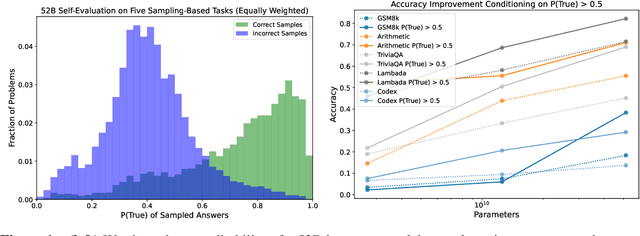

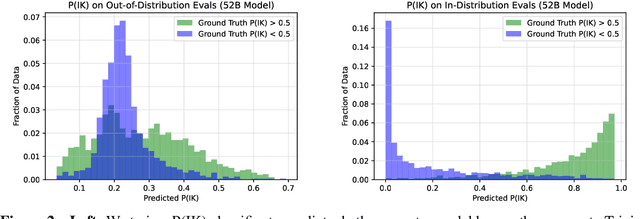

Abstract:We study whether language models can evaluate the validity of their own claims and predict which questions they will be able to answer correctly. We first show that larger models are well-calibrated on diverse multiple choice and true/false questions when they are provided in the right format. Thus we can approach self-evaluation on open-ended sampling tasks by asking models to first propose answers, and then to evaluate the probability "P(True)" that their answers are correct. We find encouraging performance, calibration, and scaling for P(True) on a diverse array of tasks. Performance at self-evaluation further improves when we allow models to consider many of their own samples before predicting the validity of one specific possibility. Next, we investigate whether models can be trained to predict "P(IK)", the probability that "I know" the answer to a question, without reference to any particular proposed answer. Models perform well at predicting P(IK) and partially generalize across tasks, though they struggle with calibration of P(IK) on new tasks. The predicted P(IK) probabilities also increase appropriately in the presence of relevant source materials in the context, and in the presence of hints towards the solution of mathematical word problems. We hope these observations lay the groundwork for training more honest models, and for investigating how honesty generalizes to cases where models are trained on objectives other than the imitation of human writing.
Scaling Laws and Interpretability of Learning from Repeated Data
May 21, 2022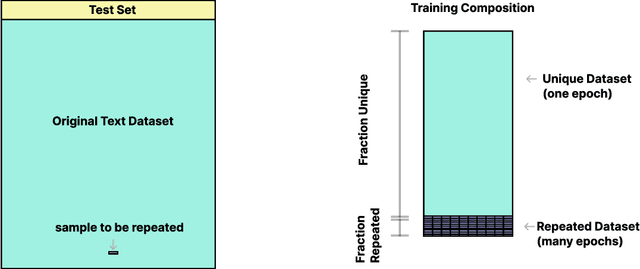



Abstract:Recent large language models have been trained on vast datasets, but also often on repeated data, either intentionally for the purpose of upweighting higher quality data, or unintentionally because data deduplication is not perfect and the model is exposed to repeated data at the sentence, paragraph, or document level. Some works have reported substantial negative performance effects of this repeated data. In this paper we attempt to study repeated data systematically and to understand its effects mechanistically. To do this, we train a family of models where most of the data is unique but a small fraction of it is repeated many times. We find a strong double descent phenomenon, in which repeated data can lead test loss to increase midway through training. A predictable range of repetition frequency leads to surprisingly severe degradation in performance. For instance, performance of an 800M parameter model can be degraded to that of a 2x smaller model (400M params) by repeating 0.1% of the data 100 times, despite the other 90% of the training tokens remaining unique. We suspect there is a range in the middle where the data can be memorized and doing so consumes a large fraction of the model's capacity, and this may be where the peak of degradation occurs. Finally, we connect these observations to recent mechanistic interpretability work - attempting to reverse engineer the detailed computations performed by the model - by showing that data repetition disproportionately damages copying and internal structures associated with generalization, such as induction heads, providing a possible mechanism for the shift from generalization to memorization. Taken together, these results provide a hypothesis for why repeating a relatively small fraction of data in large language models could lead to disproportionately large harms to performance.
Training a Helpful and Harmless Assistant with Reinforcement Learning from Human Feedback
Apr 12, 2022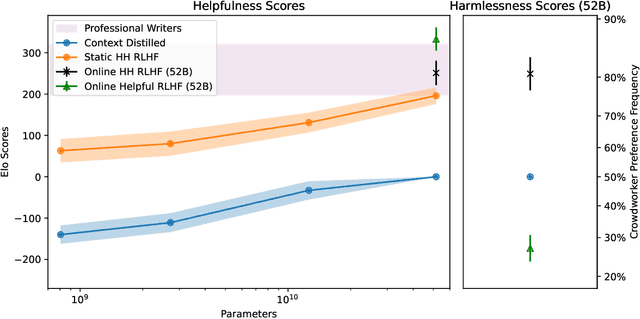
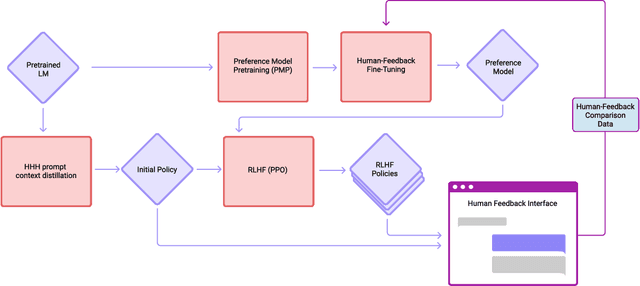

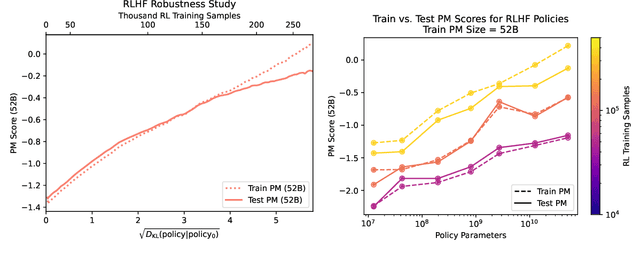
Abstract:We apply preference modeling and reinforcement learning from human feedback (RLHF) to finetune language models to act as helpful and harmless assistants. We find this alignment training improves performance on almost all NLP evaluations, and is fully compatible with training for specialized skills such as python coding and summarization. We explore an iterated online mode of training, where preference models and RL policies are updated on a weekly cadence with fresh human feedback data, efficiently improving our datasets and models. Finally, we investigate the robustness of RLHF training, and identify a roughly linear relation between the RL reward and the square root of the KL divergence between the policy and its initialization. Alongside our main results, we perform peripheral analyses on calibration, competing objectives, and the use of OOD detection, compare our models with human writers, and provide samples from our models using prompts appearing in recent related work.
A General Language Assistant as a Laboratory for Alignment
Dec 09, 2021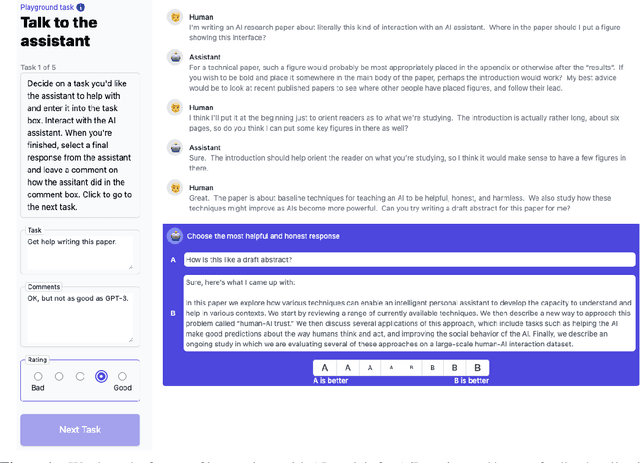
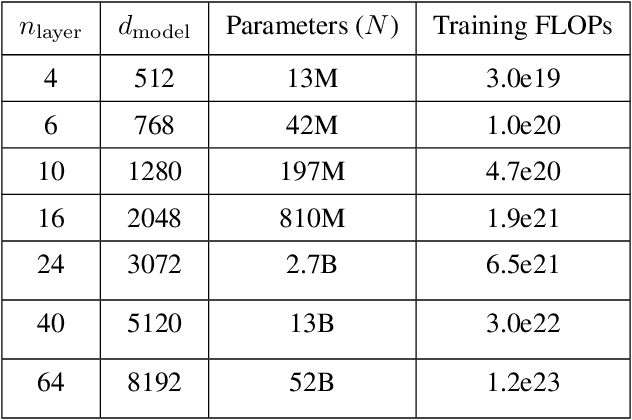
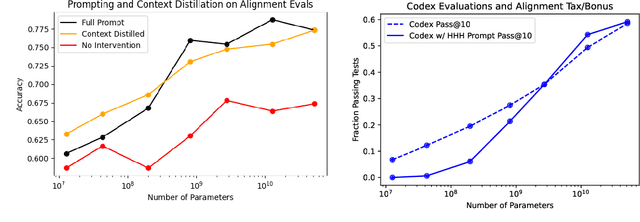
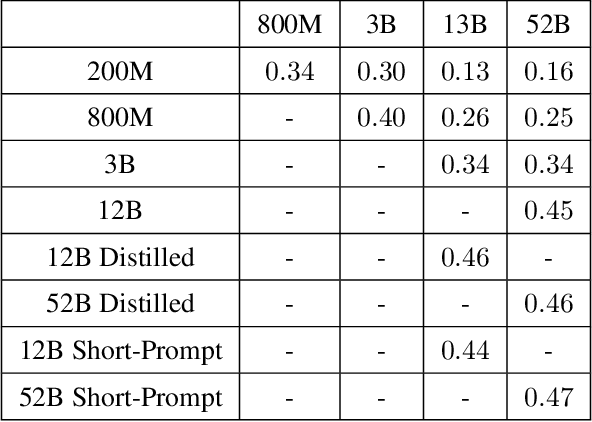
Abstract:Given the broad capabilities of large language models, it should be possible to work towards a general-purpose, text-based assistant that is aligned with human values, meaning that it is helpful, honest, and harmless. As an initial foray in this direction we study simple baseline techniques and evaluations, such as prompting. We find that the benefits from modest interventions increase with model size, generalize to a variety of alignment evaluations, and do not compromise the performance of large models. Next we investigate scaling trends for several training objectives relevant to alignment, comparing imitation learning, binary discrimination, and ranked preference modeling. We find that ranked preference modeling performs much better than imitation learning, and often scales more favorably with model size. In contrast, binary discrimination typically performs and scales very similarly to imitation learning. Finally we study a `preference model pre-training' stage of training, with the goal of improving sample efficiency when finetuning on human preferences.
Concrete Problems in AI Safety
Jul 25, 2016Abstract:Rapid progress in machine learning and artificial intelligence (AI) has brought increasing attention to the potential impacts of AI technologies on society. In this paper we discuss one such potential impact: the problem of accidents in machine learning systems, defined as unintended and harmful behavior that may emerge from poor design of real-world AI systems. We present a list of five practical research problems related to accident risk, categorized according to whether the problem originates from having the wrong objective function ("avoiding side effects" and "avoiding reward hacking"), an objective function that is too expensive to evaluate frequently ("scalable supervision"), or undesirable behavior during the learning process ("safe exploration" and "distributional shift"). We review previous work in these areas as well as suggesting research directions with a focus on relevance to cutting-edge AI systems. Finally, we consider the high-level question of how to think most productively about the safety of forward-looking applications of AI.
TensorFlow: Large-Scale Machine Learning on Heterogeneous Distributed Systems
Mar 16, 2016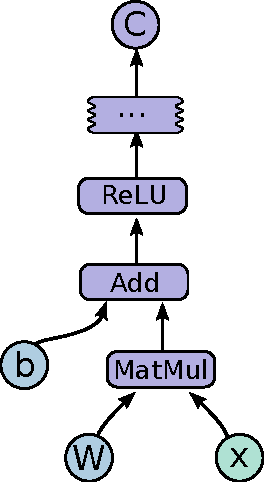

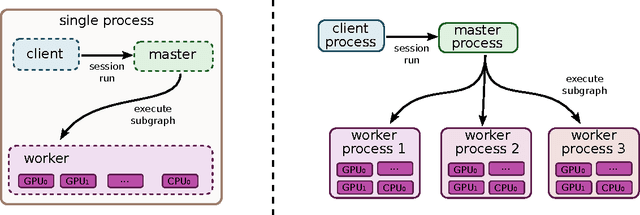
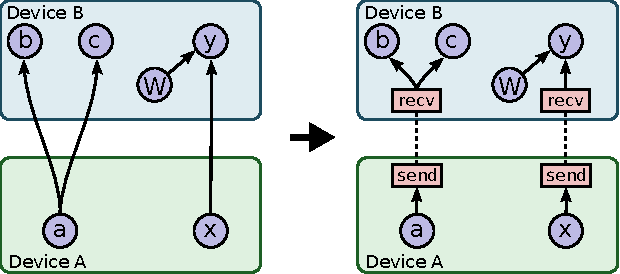
Abstract:TensorFlow is an interface for expressing machine learning algorithms, and an implementation for executing such algorithms. A computation expressed using TensorFlow can be executed with little or no change on a wide variety of heterogeneous systems, ranging from mobile devices such as phones and tablets up to large-scale distributed systems of hundreds of machines and thousands of computational devices such as GPU cards. The system is flexible and can be used to express a wide variety of algorithms, including training and inference algorithms for deep neural network models, and it has been used for conducting research and for deploying machine learning systems into production across more than a dozen areas of computer science and other fields, including speech recognition, computer vision, robotics, information retrieval, natural language processing, geographic information extraction, and computational drug discovery. This paper describes the TensorFlow interface and an implementation of that interface that we have built at Google. The TensorFlow API and a reference implementation were released as an open-source package under the Apache 2.0 license in November, 2015 and are available at www.tensorflow.org.
 Add to Chrome
Add to Chrome Add to Firefox
Add to Firefox Add to Edge
Add to Edge